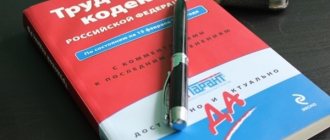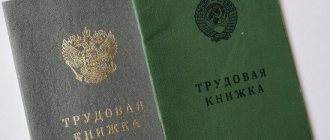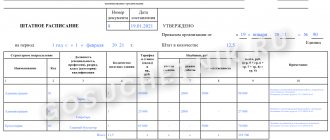Insurance experience - what is it?
This indicator represents the sum of the periods of work of a citizen throughout his life for which deductions were made.
It only accumulates when the employer pays the contributions. To do this you need to be officially employed.
If a citizen does not work because he is unemployed, is sick, or is caring for a child, these periods are not counted.
From 01/01/2015, the amount of insurance pension provision depends on the individual pension coefficient (IPC). IPC is the total points that were awarded to a Russian citizen for the entire period of his working activity. The IPC is accrued every year. If the Russian was not employed, then the IPC is not accrued.
Here you can see how production affects pension payments. The greater the output of a Russian, the greater the number of IPCs he will receive. If before 2015, the amount of pension payments depended more heavily on the amount of insurance contributions that employers paid to the Pension Fund for an employee, today the pension depends more on the number of individual industrial complexes. The higher the Russian’s salary and the more years he worked, the more IPC will accumulate.
Which one is needed for retirement?
After the pension reform of 2015, the conditions for registration of old-age pension insurance became more stringent. If before 2002 the registration of pension payments did not depend on production, then when the bill “On Labor Pensions” came into force, insurance pension payments began to be issued only if there was at least five years of production.
To retire in 2021, you need to have accumulated at least ten years of earnings. Once every 12 months, this indicator will increase by one, until 2025.
Kinds
It depends on how actively a citizen was engaged in labor activity before retirement, whether he will be assigned an insurance pension and what the amount of payments will be. At the same time, production is necessary to calculate both pension benefits and disability benefits.
Depending on its duration, the amount of disability benefits may be equal to:
- 60 percent of the average salary;
- 80 percent;
- 100 percent.
The procedure for calculating periods of work activity for both cases differs and depends on the periods under consideration. To register and calculate pension benefits, general and special insurance periods are distinguished.
Differences between insurance experience and work experience
The general insurance period is also called labor experience. It is equal to the duration of the periods of working activity of Russians, during which the employer made contributions to the Pension Fund. At the same time, the citizen’s work activity must be recorded in a work book issued for each employed employee. Using it, it is possible to calculate the length of work experience to calculate the old-age pension issued.
Work experience differs from insurance in that it includes exclusively those periods during which a person was officially employed. The insurance period also includes periods that differ from official employment.
Calculation according to work book
The work book is the main document according to which the length of service is calculated for an individual. When calculating the insurance period, you can use a simple formula, as well as an online calculator. If a person has worked in one place all his life, then calculating the total length of service is quite simple. It is necessary to calculate the number of working days for each year separately, convert days into months, and months into years.
Formula for calculating pensions based on length of service
If there are many jobs, it is best to write down each place of work in a column and, on the contrary, indicate the date of admission and date of dismissal. Then, for each place of work, you should calculate the number of days in months and years. When calculating insurance or work experience, each month is counted as 30 days, and the day of hiring and the day of dismissal is counted as 1 day.
What periods are included?
So, it was established that the insurance period necessarily includes periods of official employment of a citizen. It also includes periods when a Russian:
- served in the army;
- received benefits because he was temporarily disabled;
- looked after a son/daughter, and the child was under one and a half years old;
- received unemployment benefits, performed paid public works, moved to another locality to find a job in the direction of the employment center;
- was in prison, but at the same time managed to prove his own innocence and the fact that he was unjustifiably detained;
- cared for a person with a category 1 disability, a minor with a disability, an elderly person (over 80 years old);
- lived in a locality where he could not find employment for a maximum of 5 years (for military spouses);
- lived in a foreign country for a maximum of 5 years (for husbands/wives of Russians who work in diplomatic missions and embassies of Russia).
- study in higher educational institutions, but there are restrictions.
The listed periods are counted as output if before and after them the citizen was officially employed for at least 1 day.
The procedure for calculating length of service
The methodology for calculating insurance periods was approved by order of the Ministry of Health and Social Development No. 91 of 02/06/2007.
The document contains fundamental rules that are used by all personnel officers and other specialists. They can be briefly summarized as follows:
- Continuous periods are periods of work with one employer.
- They are calculated by subtracting the date of dismissal from hiring.
- The insurance period is the totality of the above data obtained over the entire period of work.
- The following axioms are used in calculations:
- a year consists of 12 months;
- one month consists of 30 days (no matter how indicated in the calendar).
- If, when calculating days, there are more than 30, then you should convert them into a month.
- The same thing has to be done when it turns out to be more than 12 months - they are converted into a year.
- The calculation of labor time intervals is carried out in calendar order.
For information: nowadays there are programs for automatic calculations.
Their algorithm takes into account the above rules. Download for viewing and printing: Order of the Ministry of Health and Social Development of Russia dated 02/06/2007 N 91 (as amended on 11/15/2016) “On approval of the Rules for calculating and confirming the insurance period”
Calculation formula
The day of dismissal is included in the calculations.
The following formula is used for calculations:
- StS = OKDn / 30 days, where:
- StS - insurance experience;
- OKDN - the total number of days when a person officially worked, taking into account preferential ones.
For reference: the old-age insurance pension in 2021 was assigned to people who had at least 10 years of experience, in 2021 - 11 years.
Periods counted in the insurance period
Article 16 of Law No. 27-FZ lists all periods of time that are included in insurance. These include, in particular, the following intervals:
- Work under an employment agreement.
- Carrying out activities under a civil contract:
- civil service;
- service in civil and municipal bodies;
- service in the army and equivalent government institutions;
- Temporary disability due to illness.
- Care period:
- for a newborn up to one and a half years old (in total no more than 6);
- for a disabled child;
- for a disabled person of group 1;
- for an elderly citizen who has crossed the 80-year-old threshold.
- Status registered with employment authorities.
- Participation in paid community work.
- For rehabilitated persons - time spent under arrest and serving a sentence.
- The period of voluntary transfer of contributions to the Pension Fund by a person who is not included in the compulsory insurance system.
- The period during which the individual who entered the compulsory insurance system voluntarily paid contributions for the applicant.
- Living with a military spouse in an area where employment in the specialty is impossible, including abroad.
Attention: the specified preferential periods of time will be taken into account in the StS if the person worked officially before they began or after completion (Article 11 of Law No. 400-FZ).
All other periods will not be included in the length of service. For the self-employed population (individual entrepreneurs, notaries, etc.), the insurance period will include the time period during which contributions to the Pension Fund were transferred.
Download for viewing and printing:
Federal Law of April 1, 1996 N 27-FZ (as amended on December 28, 2016) “On individual (personalized) registration in the compulsory pension insurance system”
Example
Sergei Petrovich worked in three private companies, as indicated in his Labor Code:
- LLC "Scarlet Sails": from 10/16/1996 to 02/18/2001;
- JSC "Volt": from 02/19/2001 to 09/22/2008;
- Parus LLC: from 09/23/2008 to 06/01/2017.
To determine the total length of service, it is necessary to calculate the lengths of continuous service at each enterprise:
- 02/18/2001 - 10/16/1996 = 02 days. 02 months 4 years.
- 09/22/2008 - 02/19/2001 = 03 days. 07 months 7 years.
- 06/01/2017 - 09/23/2008 = 08 days. 07 months 8 years.
Let's sum up the periods: 02 days. 02 months 4 years + 03 days 07 months 7 l. + 08 days 07 months 8 l. = 13 days 04 months 20 years.
Attention: the rules for converting time intervals were used for calculations (see above).
What to do if the archive is missing
If the necessary documents are missing, the time of work can be confirmed by witnesses. In this case, you must provide a certificate stating that the archive has not been saved. This is possible for the following reasons:
- carrying out military operations;
- natural disasters (tsunami, flood, earthquake(;
- emergency situations (accidents, disasters, etc.).
To confirm the length of service, testimony of two or more witnesses who worked with the applicant during that period of time is required.
When determining the period of work, the age of the applicant is taken into account:
- the time spent working is taken into account from the moment the applicant turns 16;
- if hired labor was used during the holidays, then the period of work starting from 15 years (in rare cases - from 14 years) is taken into account.
If there are discrepancies in the testimony of witnesses regarding the time period, the period of time confirmed by both witnesses is taken as a basis.
How to find out your period using SNILS and the Pension Fund
For people who want to check their insurance record, visiting the Pension Fund office in person seems to be the most difficult method. However, if online services are for some reason unavailable, you will have to go to the Pension Fund. You must take your passport and SNILS with you. Once your identity has been confirmed, a Pension Fund employee will help you draw up a request for information. You will have to wait approximately 10 days for a response.
People who prefer to use the Internet rather than visit government agencies can check their output through the government services website or the website of the Pension Fund of the Russian Federation.
In order to obtain information, you need to register on the government services portal and fill out a form. You will need to write:
- passport data;
- date of birth;
- phone number;
- SNILS.
In addition to filling out the form, you need to complete verification. This can be done at the Pension Fund branch, through the post office, using a universal electronic card. You need to do this once in order to have unhindered access to all government services in the future.
Select the appropriate service and fill out a special form. The information you request is located on the server equipment of the Pension Fund and will be sent to you after verification.
The insurance period according to SNILS can also be checked through the Pension Fund website:
- Log in to your profile using data from the government services website.
- Select a service, after which you will be shown information about the accumulated experience.
In addition, you will see the number of IPCs.
Also, each citizen can obtain information on personal insurance history at their place of work. The HR department or other department issues a document based on data from the work book.
Sample certificate of work experience:
Calculation without a work book
When you have a work book in hand, the insurance period is calculated based on the dates of admission and dismissal.
Much more problems arise if the work book is lost. When there is only one place of work and the organization has not ceased its activities, then it is enough to contact the personnel department of the institution and get a certificate about the date of employment and dismissal. Such a document, certified by the seal of the enterprise, has legal force and can be presented to the Pension Fund for calculating a pension. Valorization of pensions: what is it?
If there were several places of work, then the procedure for visiting HR departments will have to be done multiple times. It will be somewhat more difficult for those individuals whose organizations or enterprises have been completely disbanded and ceased their activities. This was especially the case in the 90s, when not only small institutions closed, but also large industrial enterprises with thousands of employees went bankrupt. As a rule, all documentation of state enterprises is transferred to the archive for storage.
Old-age pension law: all articles and regulations
In some cases, work data can be confirmed by extracts from organizational orders and copies of payroll statements.
Access to the archive
First, you need to clarify which archival department you should contact to obtain information on the issue of interest. Since the document is necessary for calculating a pension, information on where to apply can be found at the Pension Fund. The law does not establish a specific form for a request to the archive, so the application is written independently in free form, but indicating the required details.
What subsidies and benefits can Russian pensioners count on?
The full name of the institution to which the application is being sent is written in the header of the application. Then the following data is indicated:
- surname, name, patronymic of the applicant;
- date of birth, address and all contacts;
- Business name;
- department and position;
- approximate period of work;
- for what purpose is the certificate required;
- date, personal signature.
Sample request to the archive for restoration of a work book
If the surname has been changed, then the old and new surnames must be indicated. The purpose of obtaining a certificate is the requirement of the Pension Fund related to the registration of a pension. The archival document required for pension accrual is issued free of charge within 30 days from the date of registration of the application.
There are often cases when a future retiree changes his region of residence. In this case, there is no need to personally contact your former place of work. The request application should be sent by registered mail with acknowledgment of receipt, having previously specified the address of the organization.
Lack of archival confirmation
The situation is much more complicated when not only the work book is missing, but also archival documents for a specific institution. In the 90s, there were many cases when employers disappeared along with all financial documentation, depriving their former employees of the opportunity to confirm their experience in this organization.
It makes sense to start looking for certificates to confirm your experience only if a “white” salary, that is, an official salary, was paid during the required period. If the money was paid “in an envelope,” this means that the employer did not pay contributions for its employees, and this period of professional activity is not included in the insurance period.
If an organization or enterprise has been liquidated, but there is a legal successor, then providing the necessary documents becomes his responsibility. You can find out about the presence of a legal successor in the tax service of the region where the liquidated organization was located. If there is no successor, then you should find out the level of subordination of the organization. With federal subordination, documents are located in the federal archive, with municipal or regional subordination - in the appropriate archives.
Interviewing witnesses
If no traces of activity, as well as documentation of the disbanded organization, could be found, then the only evidence of activity in this institution may be testimony.
Moreover, there must be at least two witnesses. They must submit certificates of employment in this institution at the same time as the person whose period of work they confirm. In this case, an application is written to the Pension Fund at the place of permanent residence, which sets out a request to establish a period of work, taking into account the testimony of witnesses. The application must include their names and addresses. The application must be accompanied by a certificate from the archive, which indicates that among the storage units there are no documents for the enterprise where the applicant worked.
If there is no work book, there are no supporting documents in the archives, and no witnesses have been found, then this period is not suitable for calculating a pension.
How to calculate
The procedure for calculating the insurance period is regulated by Art. 13 Federal Law No. 400. It provides the following:
- calculation is made according to the calendar principle;
- self-employed citizens or citizens working under a contract with an individual accumulate experience if they have paid contributions to the Pension Fund;
- if a citizen has applied for a pension in another country, using certain periods of work, then in Russia these periods can no longer be applied;
- people who have length of service obtained before the 2015 changes have the right to decide how to calculate it - according to the new laws or the old ones.
Periods of work activity after the introduction of individual accounting and SNILS are subject to automatic confirmation based on the information recorded on the Russian’s personal account.
The calculation formula is elementary. All periods that can be counted as production are added up. The result obtained will be the insurance period.
Calculation example
Anna was officially employed for 20 years. During her working life, she gave birth to 2 children, with each of whom she was on maternity leave for 36 months.
After that, Anna became an individual entrepreneur and worked as an individual entrepreneur for 7 years. Moreover, out of these 7 years, she worked part-time for 2 years.
Its output will be calculated as follows:
- The work done while caring for a child is counted only for the first year and a half. During 2 maternity leaves, Anna accumulated 3 years of experience.
- If a person works part-time as an individual entrepreneur, the output is not counted, since there are no transfers to the Pension Fund.
- We sum up the difference of 20 and 3 with the difference of 7 and 2. The result is that Anna has accumulated 22 years of output.
The main document that confirms periods of work is still considered the work book. The information reflected in the document is checked by employees of the Pension Fund of the Russian Federation and taken into account when calculating length of service (if the employer made contributions to the Pension Fund). If a citizen meets the minimum length of service requirements, he is assigned an insurance pension, the amount of which depends on the length of work and earnings.
Determining the insurance period for paying sick leave
The instructions, approved by order of the Ministry of Health and Social Development of the Russian Federation No. 91, contain a methodology for calculating length of service for paying for periods of temporary disability.
They are necessary, since the amount of the benefit directly depends on the time previously spent on labor or socially useful work. This dependence is contained in Article 7 of Law No. 255-FZ of December 29, 2006. In particular, the document defines:
- 100% of average monthly earnings during periods of illness are accrued to workers who have worked in total for more than 8 years;
- 80% of the specified amount is received by those whose experience varies from 5 to 8 years;
- 60% - from six months to five years.
Attention: if a worker has not worked for six months, then sick leave is accrued to him based on the minimum wage established for the corresponding period.
The algorithm of actions of the specialist responsible for calculating sick leave payments is as follows:
- All periods of employment are written out from the Labor Code.
- Continuous periods are calculated (at one enterprise).
- Their totality is determined.
- Compares with the boundary indicators (indicated above).
- Interests are entered into the protocol, on the basis of which the accountant calculates earnings during the period of incapacity.
Attention: the worker himself can control the accruals using the above calculation method.
Download for viewing and printing: Federal Law N255-FZ “On compulsory social insurance in case of temporary disability and in connection with maternity”










